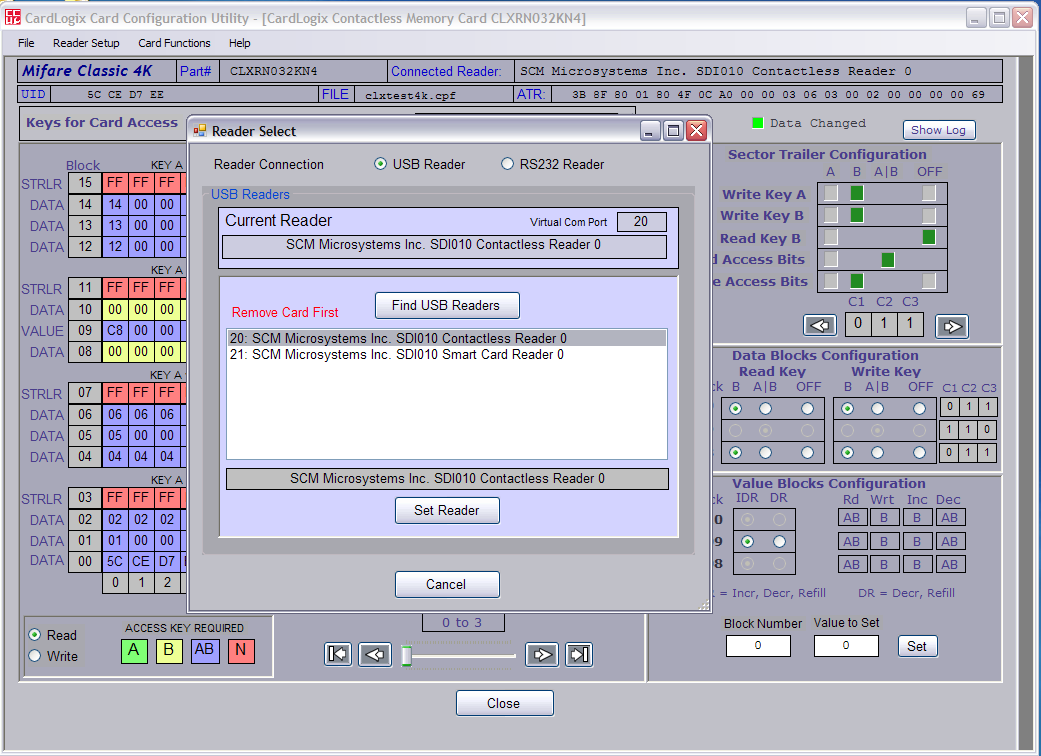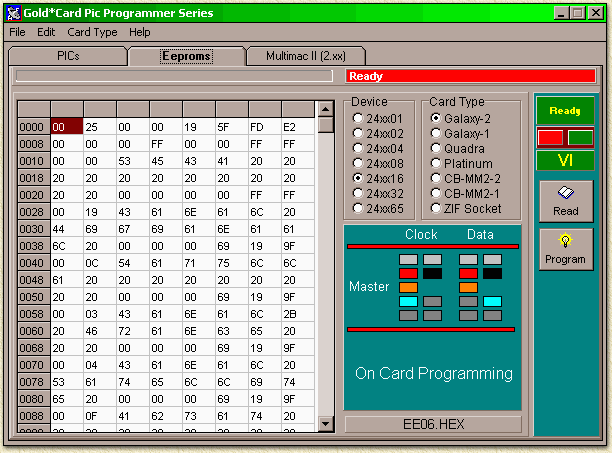programming software - A programming tool or software development tool is a program or application that software developers use to create, debug, maintain, or otherwise support other programs and applications.
smart card - A plastic card with a built-in microprocessor, used typically for electronic processes such as financial transactions and personal identification
- a plastic card containing a microprocessor that enables the holder to perform operations requiring data that is stored in the microprocessor; typically used to perform financial transactions
- A smart card, chip card, or integrated circuit card (ICC), is any pocket-sized card with embedded integrated circuits. There are two broad categories of ICCs. Memory cards contain only non-volatile memory storage components, and perhaps dedicated security logic.
- (Smart Cards (Chip Cards)) There are various types of Smart Cards, sometimes called Chip Cards. Electronic chips allow these credit cards to function in different ways: as credit cards, debit cards, frequent buyer or rewards program cards, I.D. cards, or any combination. Many college I.D.
smart card programming software - Beginning Smartphone
Beginning Smartphone Web Development: Building JavaScript, CSS, HTML and Ajax-based Applications for iPhone, Android, Palm Pre, BlackBerry, Windows Mobile and Nokia S60
Today’s Web 2.0 applications (think Facebook and Twitter) go far beyond the confines of the desktop and are widely used on mobile devices. The mobile Web has become incredibly popular given the success of the iPhone and BlackBerry, the importance of Windows Mobile, and the emergence of Palm Pre (and its webOS platform). At Apress, we are fortunate to have Gail Frederick of the well-known training site Learn the Mobile Web offer her expert advice in Beginning Smartphone Web Development. In this book, Gail teaches the web standards and fundamentals specific to smartphones and other feature-driven mobile phones and devices.
Shows you how to build interactive mobile web sites using web technologies optimized for browsers in smartphones
Details markup fundamentals, design principles, content adaptation, usability, and interoperability
Explores cross-platform standards and best practices for the mobile Web authored by the W3C, dotMobi, and similar organizations
Dives deeps into the feature sets of the most popular mobile browsers, including WebKit, Chrome, Palm Pre webOS, Pocket IE, Opera Mobile, and Skyfire
By the end of this book, you’ll have the training, tools, and techniques for creating robust mobile web experiences on any of these platforms for your favorite smartphone or other mobile device.
What you’ll learn
Build interactive mobile web pages that comply with industry standards and best practices.
Develop web sites using the markup languages of the mobile Web: XHTML-MP, Wireless CSS, and WML.
Use Mobile JavaScript and Ajax for client-side web interactivity.
Adapt the syntax and design of mobile web pages to target smartphone models.
Enhance mobile web pages to target advanced features of smartphone browsers.
Validate and compress mobile markup to optimize for network transmission and browser performance.
Simulate smartphone browsers using emulators and development tools.
Who this book is for
Mobile application developers and their managers need to learn mobile web technologies because it’s in their economic interest. Time-to-market and opportunity costs are significantly lower for web-based mobile applications than for native ones.
Desktop web developers at software companies and IT departments of non-technology businesses need to learn mobile web technologies to meet the demands of managers who will soon be asking them to “mobilize this web site.” These developers will want to do the minimum work possible to maximize the compatibility of their mobile web sites. The standards-based approach advocated in this book will allow them to build gracefully adaptive and portable mobile web experiences that perform well across mobile browser platforms.
Table of Contents
Introduction to Mobile Web Development
Set Up Your Mobile Web Development Environment
Mobile Markup Languages
Device Awareness and Content Adaptation
Adding Interactivity with JavaScript and AJAX
Mobile Web Usability
Enhancing Mobile Web Pages for Smartphone Browsers
Optimizing Mobile Markup
Validating Mobile Markup
Testing a Mobile Web Site
Deploying a Mobile Web Site
How to Play Well in the Mobile Ecosystem
The Future of the Mobile Web
director 7
Dr. Matthias Kaiserswerth Director and Vice President IBM Research – Zurich In June 2006 Matthias Kaiserswerth has been named director of IBM Research – Zurich. In addition, he holds a position in the Software Research Strategy Board, in which he coordinates research work in this area across IBM's twelve global research laboratories. From 2002 until the end of 2005 he was the Managing Director of an IBM Integrated Account. In 2000 Matthias Kaiserswerth became the director of IBM's laboratory in Zurich. Additional responsibilities were for the IBM Zurich Industry Solutions Lab where IBM hosts customers to meet with its researchers to discuss future technology and emerging business trends. From 1997 through 1999, Dr. Kaiserswerth was on assignment at the IBM TJ Watson Research Center where he led the networking software and security research. In addition, he was responsible for setting IBM Research's global security research strategy and starting IBM efforts in the emerging field of privacy technology research. From 1988 through 1997 he worked as a Research Staff Member at IBM Research – Zurich on various research projects ranging from high-performance communication systems to message brokering in a medical environment. Most recently, he worked on smart cards and Java security, which lead to the OpenCard industry standard for using smart cards in a Java environment and Visa's Java Cardtm Price Breakthrough program based on the IBM Research – Zurich JCOP platform. Dr. Kaiserswerth received his MSc and PhD in Computer Science from McGill University in Montreal, Canada and from Friedrich-Alexander University in Erlangen-Nuremberg, Germany respectively. Since May 2012 Dr. Kaiserswerth has been President of the Economic Development Agency Zimmerberg-Sihltal. He is also on the founding Board of Trustees at TECHNOPARK ® Zurich and HASLERSTIFTUNG Bern. Dr. Kaiserswerth maintains a blog at ibmzrl.wordpress.com/
k8048
successfully programmed a PIC12F509 via K8048, and new software. this software is rather 'toxic', as it would be possible (in theory), to program smart cards, means ATM and pay TV, if you only would have 'the codes'. well i do not have them, and also i do not have a set-top box for pay TV. but it is the same technology- which should be treated as if 'the man would be inside'. no really. superstition and matrix- all three sequels.. in the order matrix 3, matrix 1, matrix 2 i have three programmers now, my USB module can not access baseline PIC anymore- because of firmware update, which is not backwards compatible. luckily, new software can program many PIC variants using the K8048 from VELLEMANN (purchased via MAPLIN). also there is a picture of this programmer PCB..two pictures from here. oh yes, i must say, for superstition reason, i do not use this K8048 directory anymore for new projects. the old software still resides..including supplied example code!
smart card programming software
A complete nuts-and-bolts guide to designing, building, and managing the smart card system that's right for your company
Already a well-established medium of exchange in Europe, smart card technology has made major inroads in the North American market in the past few years. Visa and Mastercard are committed to replacing credit cards with them over the next five years, and Microsoft is racing to use them for e-commerce. Clearly, the time for asking 'Why?' regarding smart cards has passed. The important question companies now should be asking themselves is 'How?': how to plan, how to develop, how to implement, and how to manage the smart card system that is right for our company? This book provides complete, unbiased answers to these and all your technical and business questions about smart card systems.
Dreifus and Monk guide you step-by-step through the entire process of selecting, designing, building, and managing a smart card application tailored to your business. They supply numerous checklists to help guarantee that you make the correct technical decisions during each phase of the process. And they include real-world case studies illustrating successful smart card implementations in a variety of industries, including banking, manufacturing, entertainment, healthcare, and transportation. Crucial topics covered in detail include:
* Smart card architectures and standards
* Security and encryption
* Smart card operating systems
* Smart card application design and development
* Development tools
* Testing and certification
Smart Cards arms you with everything you need to know to make informed decisions about the smart card system that's right for your company.


